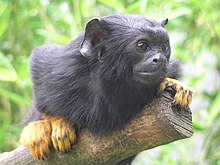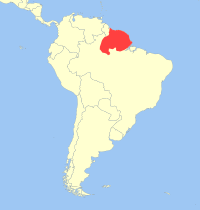Golden-handed tamarin
| Red-handed tamarin[1] | |
|---|---|

| |
| Scientific classification | |
| Kingdom: | |
| Phylum: | |
| Class: | |
| Order: | |
| Family: | |
| Genus: | |
| Species: | S. midas
|
| Binomial name | |
| Saguinus midas | |

| |
| Geographic range in South America | |
| Synonyms | |
|
Simia midas Linnaeus, 1758 | |
The red-handed tamarin (Saguinus midas), also known as the golden-handed tamarin or Midas tamarin, is a New World monkey named for the contrasting reddish-orange hair on its feet and hands. It is native to wooded areas north of the Amazon River in Brazil, Guyana, French Guiana, Suriname, and possibly Venezuela.[2] A population of tamarins south of the Amazon River that lack the contrasting feet and hands was previously believed to be a sub-population of red-handed tamarins but is now treated as a separate species, the black tamarin.
The red-handed tamarin's body measures 20.5–28 centimetres (8.1–11.0 in); including the tail it measures 31–44 centimetres (12–17 in). It weighs 400–550 grams (0.88–1.21 lb). Its life expectancy is approximately 10 years in the wild and 16 years in captivity.
It lives in cooperative groups of 4 to 15 members with little competition within group even between breeding males. Only one female in the group will breed during breeding season with the other females suppressing the instinct. The gestation period is 140–170 days and mothers typically give birth to two offspring. Young tamarins are cared for primarily by the father and turned over to the mother only to nurse, however the entire group helps with the care of the young. Defense is a priority in a group, and when one tamarin is threatened the others will rush to its defense. The red-handed tamarin is territorial and can be aggressive, with sharp canines and claws instead of fingernails on all fingers and all but the large toe.
The red-handed tamarin is an exceptional climber and spends most of its time among the vines and branches of the trees. It is quick and agile and is a superb jumper known to jump distances of over 60 feet (18 m) from a tree to the ground with no sign of injury. Its diet consists of fruit, flowers, insects, frogs, spiders, lizards, and nectar.[2] Its natural predators include small cats, birds of prey, and snakes.
Populations of red-handed tamarins appear to be expanding into the historical range of the pied tamarin, with the red-handed tamarin gradually displacing the pied tamarin through interspecific competition.[2][4]
References
- ^ Groves, C. P. (2005). Wilson, D. E.; Reeder, D. M. (eds.). Mammal Species of the World: A Taxonomic and Geographic Reference (3rd ed.). Baltimore: Johns Hopkins University Press. p. 135. ISBN 0-801-88221-4. OCLC 62265494.
- ^ a b c d Mittermeier, R. A.; Rylands, A. B.; Boubli, J.-P. (2008). "Saguinus midas". The IUCN Red List of Threatened Species. 2008. IUCN: e.T41525A10489882. doi:10.2305/IUCN.UK.2008.RLTS.T41525A10489882.en. Retrieved 12 January 2018.
{{cite journal}}: Unknown parameter|last-author-amp=ignored (|name-list-style=suggested) (help) - ^ Linnaeus, Carl (1758). Systema naturæ. Regnum animale (10th ed.). p. 28. Retrieved 19 November 2012.
- ^ Röhe, F. (2006). Área de contato entre as distribuições geográficas de Saguinus midas e Saguinus bicolor (Callitrichidae-Primates): a importância de interações e fatores ecológicos. Dissertação de Mestrado — INPA/UFAM. p. 71.

